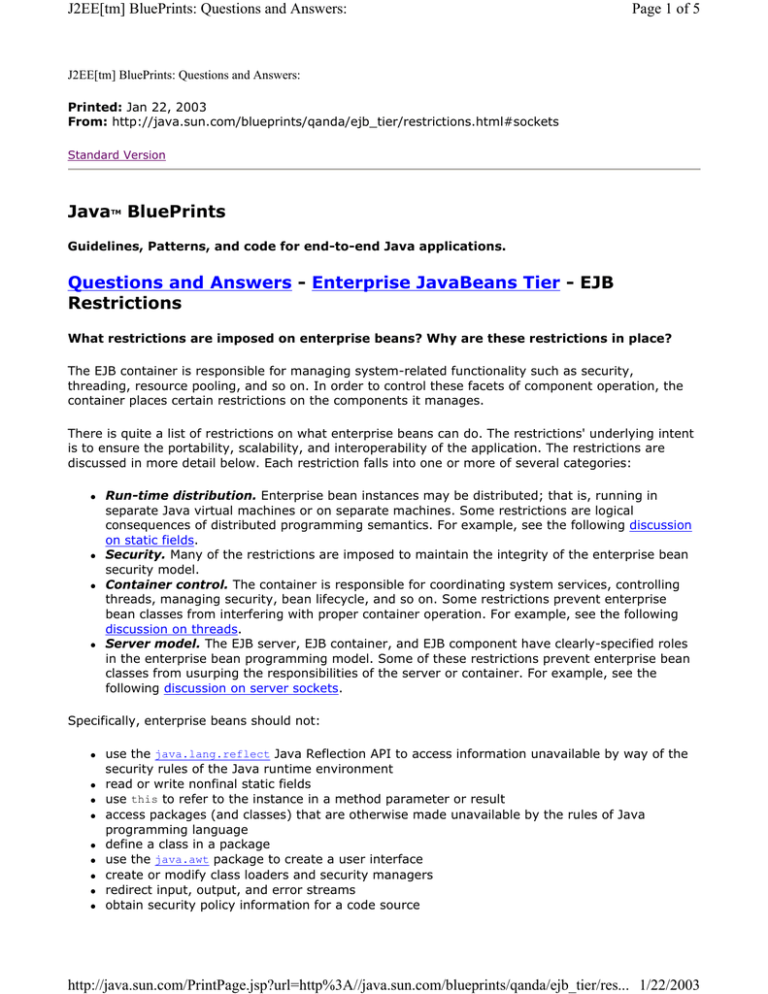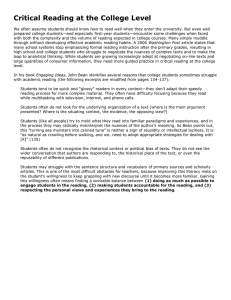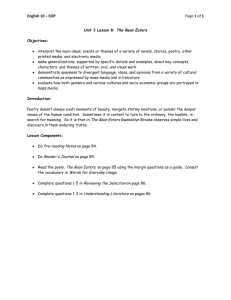
J2EE[tm] BluePrints: Questions and Answers:
Page 1 of 5
J2EE[tm] BluePrints: Questions and Answers:
Printed: Jan 22, 2003
From: http://java.sun.com/blueprints/qanda/ejb_tier/restrictions.html#sockets
Standard Version
Java BluePrints
TM
Guidelines, Patterns, and code for end-to-end Java applications.
Questions and Answers - Enterprise JavaBeans Tier - EJB
Restrictions
What restrictions are imposed on enterprise beans? Why are these restrictions in place?
The EJB container is responsible for managing system-related functionality such as security,
threading, resource pooling, and so on. In order to control these facets of component operation, the
container places certain restrictions on the components it manages.
There is quite a list of restrictions on what enterprise beans can do. The restrictions' underlying intent
is to ensure the portability, scalability, and interoperability of the application. The restrictions are
discussed in more detail below. Each restriction falls into one or more of several categories:
z
z
z
z
Run-time distribution. Enterprise bean instances may be distributed; that is, running in
separate Java virtual machines or on separate machines. Some restrictions are logical
consequences of distributed programming semantics. For example, see the following discussion
on static fields.
Security. Many of the restrictions are imposed to maintain the integrity of the enterprise bean
security model.
Container control. The container is responsible for coordinating system services, controlling
threads, managing security, bean lifecycle, and so on. Some restrictions prevent enterprise
bean classes from interfering with proper container operation. For example, see the following
discussion on threads.
Server model. The EJB server, EJB container, and EJB component have clearly-specified roles
in the enterprise bean programming model. Some of these restrictions prevent enterprise bean
classes from usurping the responsibilities of the server or container. For example, see the
following discussion on server sockets.
Specifically, enterprise beans should not:
z
z
z
z
z
z
z
z
z
use the java.lang.reflect Java Reflection API to access information unavailable by way of the
security rules of the Java runtime environment
read or write nonfinal static fields
use this to refer to the instance in a method parameter or result
access packages (and classes) that are otherwise made unavailable by the rules of Java
programming language
define a class in a package
use the java.awt package to create a user interface
create or modify class loaders and security managers
redirect input, output, and error streams
obtain security policy information for a code source
http://java.sun.com/PrintPage.jsp?url=http%3A//java.sun.com/blueprints/qanda/ejb_tier/res... 1/22/2003
J2EE[tm] BluePrints: Questions and Answers:
z
z
z
z
z
z
z
z
z
z
Page 2 of 5
access or modify the security configuration objects
create or manage threads
use thread synchronization primitives to synchronize access with other enterprise bean
instances
stop the Java virtual machine
load a native library
listen on, accept connections on, or multicast from a network socket
change socket factories in java.net.Socket or java.net.ServerSocket, or change the stream
handler factory of java.net.URL.
directly read or write a file descriptor
create, modify, or delete files in the filesystem
use the subclass and object substitution features of the Java serialization protocol
For more on these restrictions, see § 18.1.2 of the EJB 1.1 specification.
Are the restrictions mandatory? How are they enforced?
The restrictions are mandatory, since they are laid out in the specification as not optional. There are
three basic types of enforcement of these restrictions.
z
z
z
Compatibility Test Suite (CTS) and branding. Only servers that pass the CTS for the
platform are allowed to brand themselves as J2EE servers. The purpose of this branding control
is to ensure the highest level of compatibility between vendors' servers. The result is that
vendors collaborate on designs, and then compete on implementations. The CTS and J2EE
branding control indicate that the branded server does indeed implement the specification,
including enforcing restrictions on enterprise beans.
Pre-deployment checking tools. Enterprise development tools have varying levels of
checking tools that ensure that enterprise beans being deployed are well-behaved (meaning
they abide by the restrictions). Developers can then be sure they are not deploying enterprise
beans that compromise server performance, security, or availability, etc.
Security model restriction enforcement. The EJB specification defines that the EJB container
implementation should enforce the restrictions described above by way of the standard Java
security model. For example, an enterprise bean that tries to create an AWT Frame will fail, since
the default security setting for the container denies java.awt.AWTPermission.
Most EJB Container implementations will allow changes to the default security settings, so
enterprise bean programming restrictions can usually be relaxed in specific cases. It's important
to understand, though, the implications of violating the restrictions, by understanding why the
restrictions are in place.
For more on the specifics of EJB container security, see section 18.2.1.1 of the EJB 1.1 specification;
especially table 10.
Do the restrictions that apply to EJBs also apply to helper and dependent classes ?
Yes. From the point of view of the container, the enterprise bean and its helper classes form a single
functional unit. If an enterprise bean were not allowed to, say, open a file in the filesystem, and yet
had access to a helper class that was allowed to do so, the restriction on the bean would be
meaningless. Therefore, EJB component programming restrictions also apply to any helper or
dependent classes the bean may use.
Why can't I use nonfinal static fields in my enterprise bean?
Nonfinal static class fields are disallowed in EJBs because such fields make an enterprise bean difficult
or impossible to distribute. Static class fields are shared among all instances of a particular class, but
http://java.sun.com/PrintPage.jsp?url=http%3A//java.sun.com/blueprints/qanda/ejb_tier/res... 1/22/2003
J2EE[tm] BluePrints: Questions and Answers:
Page 3 of 5
only within a single Java Virtual Machine (JVMTM). Updating a static class field implies an intent to
share the field's value among all instances of the class. But if a class is running in several JVMs
simultaneously, only those instances running in the same JVM as the updating instance will have
access to the new value. In other words, a nonfinal static class field will behave differently if running
in a single JVM, than it will running in multiple JVMs. The EJB container reserves the option of
distributing enterprise beans across multiple JVMs (running on the same server, or on any of a cluster
of servers). Nonfinal static class fields are disallowed because enterprise bean instances will behave
differently depending on whether or not they are distributed.
It is acceptable practice to use static class fields if those fields are marked as final. Since final fields
cannot be updated, instances of the enterprise bean can be distributed by the container without
concern for those fields' values becoming unsynchronized.
Why is thread creation and management disallowed?
The EJB specification assigns to the EJB container the responsibility for managing threads. Allowing
enterprise bean instances to create and manage threads would interfere with the container's ability to
control its components' lifecycle. Thread management is not a business function, it is an
implementation detail, and is typically complicated and platform-specific. Letting the container
manage threads relieves the enterprise bean developer of dealing with threading issues. Multithreaded
applications are still possible, but control of multithreading is located in the container, not in the
enterprise bean.
Why can an enterprise bean not listen to or accept connections on a socket?
Because if an enterprise bean is listening on a socket, it can't be passivated -- it must always be
available. Enterprise beans can be network socket clients, and so they can use other network
resources (including other enterprise bean servers) to do their jobs. Just as with a database
connection, don't hang on to open client sockets across method calls; instead, open them,
communicate through the socket, and close it before returning from the method.
Why can't EJBs read and write files and directories in the filesystem? And why can't they
access file descriptors?
Enterprise beans aren't allowed to access files primarily because files are not transactional resources.
Allowing EJBs to access files or directories in the filesystem, or to use file descriptors, would
compromise component distributability, and would be a security hazard.
Another reason is deployability. The EJB container can choose to place an enterprise bean in any JVM,
on any machine in a cluster. Yet the contents of a filesystem are not part of a deployment, and are
therefore outside of the EJB container's control. File systems, directories, files, and especially file
descriptors tend to be machine-local resources. If an enterprise bean running in a JVM on a particular
machine is using or holding an open file descriptor to a file in the filesystem, that enterprise bean
cannot easily be moved from one JVM or machine to another, without losing its reference to the file.
Furthermore, giving EJBs access to the filesystem is a security hazard, since the enterprise bean could
potentially read and broadcast the contents of sensitive files, or even upload and overwrite the JVM
runtime binary for malicious purposes.
Files are not an appropriate mechanism for storing business data for use by components, because
they tend to be unstructured, are not under the control of the server environment, and typically don't
provide distributed transactional access or fine-grained locking. Business data is better managed using
a persistence interface such as JDBC, whose implementations usually provide these benefits. Readonly data can, however, be stored in files in a deployment JAR, and accessed with the getResource()
or getResourceAsStream() methods of java.lang.Class.
http://java.sun.com/PrintPage.jsp?url=http%3A//java.sun.com/blueprints/qanda/ejb_tier/res... 1/22/2003
J2EE[tm] BluePrints: Questions and Answers:
Page 4 of 5
Why isn't AWT available from within an enterprise bean?
Because EJBs are intended to be business-functionality-specific server extensions, not clients with
user interfaces. The purpose of an enterprise bean is to perform some service on the server in
response to a service request. This is a separate function from managing user interaction. Note that
AWT and JFC/Swing may still be used to create user interfaces that access enterprise beans through a
remote enterprise bean reference.
Why is there a restriction against using the Java Reflection APIs to obtain declared member
information that the Java language security rules would not allow? Doesn't Java
automatically enforce those rules?
Contrary to common belief, most of the Java Reflection API can be used from EJB components. For
example, loadClass() and invoke() can both be used by enterprise beans. Only certain reflection
methods are forbidden.
This restriction refers to the enabling of the security permission ReflectPermission. The
suppressAccessChecks permission target name, when enabled, allows a class to use reflection to
inspect, access, and modify protected and private members and methods in other classes. Obviously,
if EJB components are using private or protected members or methods to manage sensitive
information, this facility could be used to violate security mechanisms. Therefore, the EJB specification
explicitly restricts usage of suppressAccessChecks, to prevent the security hole that would result.
Denial of ReflectPermission is part of the standard security policy for an EJB container.
Why all the restrictions on creating class loaders and redirection of input, output, and error
streams?
Class loading is allowed, but creating custom loaders is not, for security reasons. These restrictions
exist because the EJB container has responsibility for class loading and I/O control. Allowing the EJB to
perform these functions would interfere with proper operation of the Container, and are a security
hazard.
The Java Pet Store has code that loads classes from inside an enterprise bean class using
Class.forName(), in StateMachine.
Why can't I load native code?
Native code, if allowed in enterprise beans, could cause a host of problems, including but not limited
to:
z
z
z
z
Loss of portability. Using native code implies implementing that native code on every platform
you use, or ever will use. Using native code in enterprise beans would tie those beans to the
platforms on which the code runs.
Loss of system stability. Native code is typically written in C, and so will suffer from the
liabilities of C programs, such as pointer errors, memory leaks, invalid memory references, and
so forth. Furthermore, the code is likely to be less stable than the JVM, if only because the JVM
code base is likely to be more mature. If enterprise beans were allowed to use native code, a
native code crash would probably bring the application server down.
Loss of scalability. Remember that enterprise beans are multithreaded. If enterprise beans
were allowed to use native code, that code would either have to be entirely reentrant, with
thread management code at appopriate places; or access to the native calls would have to be
synchronized by the Container. Long-running native calls would lock enterprise bean instances
into memory, preventing them from being candidates for passivation.
Compromised security. The EJB container is somewhat like the applet "sandbox", in that its
security policies define what the contained instances can do. One of the things the container
http://java.sun.com/PrintPage.jsp?url=http%3A//java.sun.com/blueprints/qanda/ejb_tier/res... 1/22/2003
J2EE[tm] BluePrints: Questions and Answers:
Page 5 of 5
does is prevent enterprise beans from scribbling on the filesystem anywhere they please. Native
code has no such restriction. So, for example, if someone breaks the deployment security in
your enterprise bean environment, they have full access to your filesystem. They can read files,
read directories, broadcast file contents, or even download and replace the server's JVM with a
security-compromised (or worse) runtime executable to commit mayhem or simply make other
security breaches easier to create.
How does the container prevent native code from being called? The container has a SecurityManager
whose standard policies (section § 18.2.1.1 of the specification, Table 10) don't set a checkLink
permission for any native library. So, attempts at executing the load() or loadLibrary() methods of
java.lang.Runtime result in a SecurityException.
The EJB specification states:
"Some Containers may allow the Deployer to grant more, or fewer, permissions to the enterprise bean
instances than specified in Table 10. Support for this is not required by the EJB specification.
Enterprise beans that rely on more or fewer permissions will not be portable across all EJB
Containers."
This means that, if your container will let you grant permission to run native code, and you don't mind
that your enterprise bean component is not portable not only by platform, but also possibly not by
server, then you can run native methods in enterprise beans. Just be aware that you're locking
yourself into a box, and taking on the liabilities (problems with security, stability, portability,
scalability, etc.) that use of native code implies. we strongly recommend against using native code in
enterprise beans.
By the way, it won't help to have your enterprise bean defer native calls to other classes, because
instances of those classes will running in the same container, and so will share the enterprise bean's
security restrictions. The enterprise bean specification states explicitly that helper classes of enterprise
beans are under the same restrictions as enterprise beans themselves.
If you absolutely must have access to native code in your system, but want to keep your enterprise
beans portable, consider wrapping the native code as an RMI technology-enabled object, and then
using the service from your enterprise bean. This solution won't solve the security problem, and may
still affect scalability, but at least if the native code crashes, it won't bring your entire application
server down. Also, EJB servers from different vendors running on multiple platforms can use this new
service. When in some future time portability becomes an issue (as it invariably does, for systems that
make it into production), your enterprise bean functionality will port to new app servers or platforms
with a minimum of pain, and you can focus on reimplementing native functionality as necessary.
Unless otherwise licensed, code in all
technical manuals herein (including articles,
FAQs, samples) is provided under this License.
Copyright © 1995-2002 Sun Microsystems, Inc.
All Rights Reserved. Terms of Use. Privacy Policy.
http://java.sun.com/PrintPage.jsp?url=http%3A//java.sun.com/blueprints/qanda/ejb_tier/res... 1/22/2003






